Business Environment Report: Analysis of Tesco, NHS, and Marie Curie
VerifiedAdded on 2023/01/18
|13
|3444
|68
Report
AI Summary
This report examines the business environments of Tesco, a private organization; NHS, a public organization; and Marie Curie, a voluntary organization. It explores their classifications, legal structures, scopes, and sizes. The report delves into the interrelation of marketing with other departments and presents a PESTLE analysis of Tesco, evaluating its political, economic, social, technological, legal, and environmental factors. A SWOT analysis is also included, offering insights into the company's strengths, weaknesses, opportunities, and threats. The report aims to provide a comprehensive understanding of how these organizations operate within their respective business environments and the factors that influence their performance.
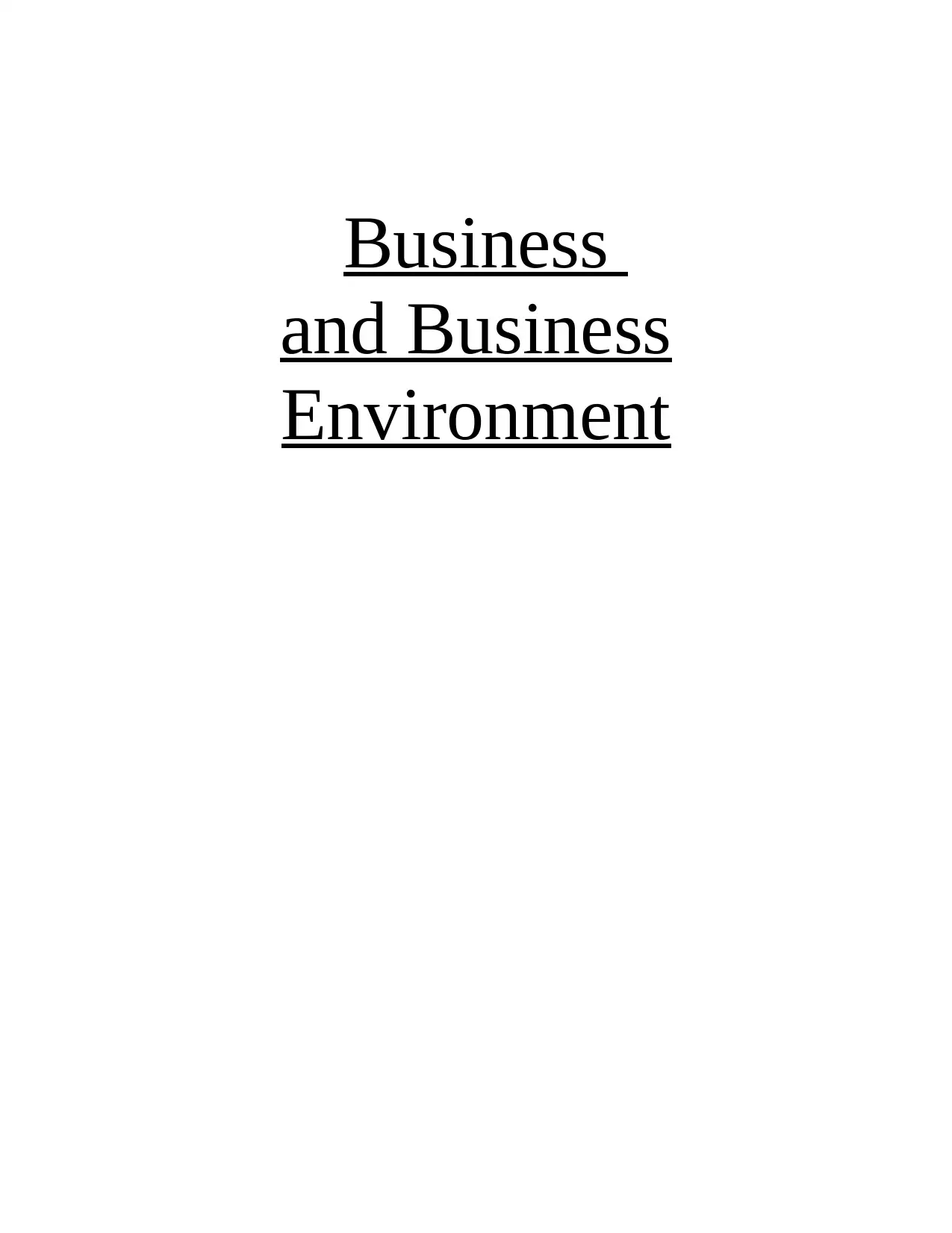
Business
and Business
Environment
and Business
Environment
Paraphrase This Document
Need a fresh take? Get an instant paraphrase of this document with our AI Paraphraser
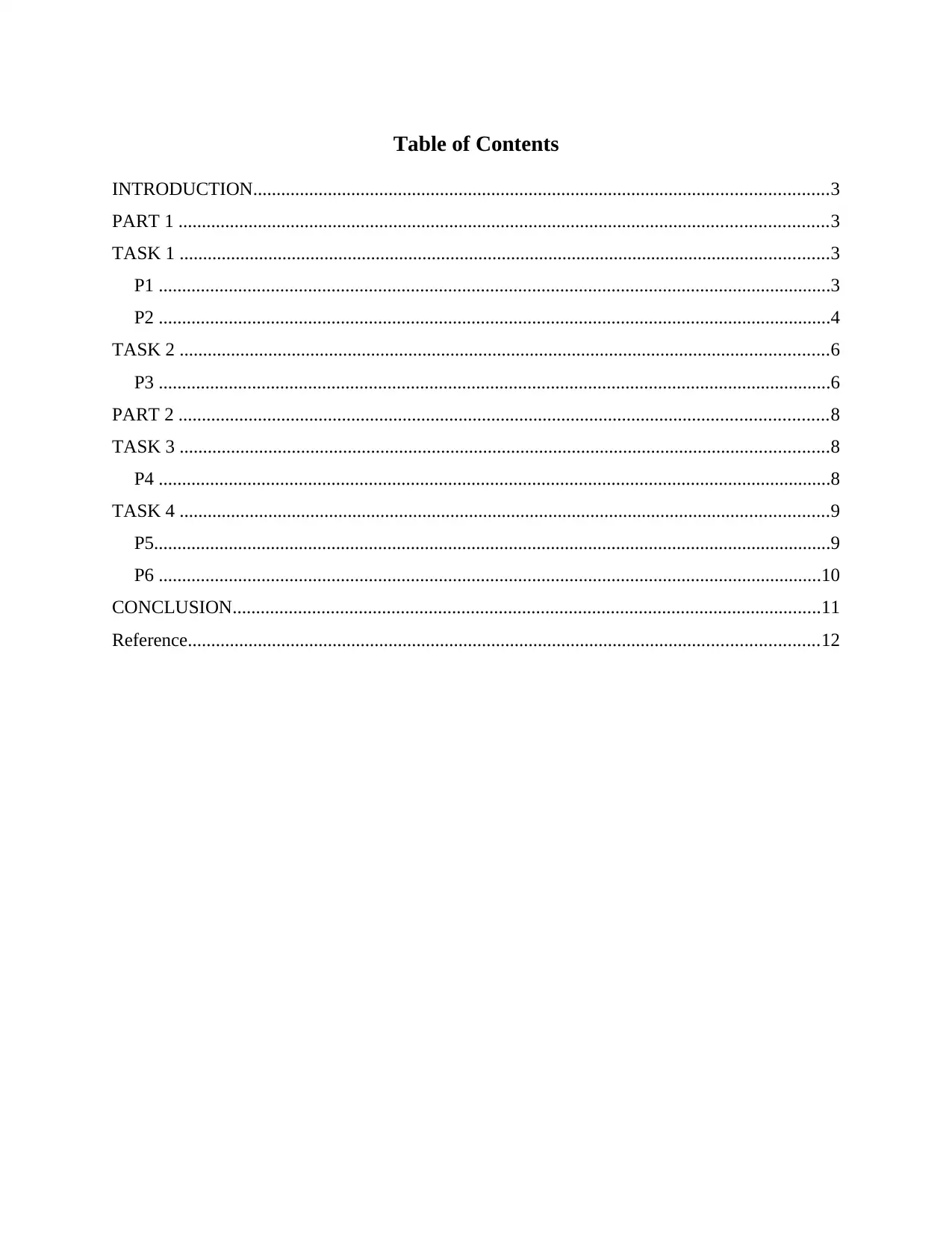
Table of Contents
INTRODUCTION...........................................................................................................................3
PART 1 ...........................................................................................................................................3
TASK 1 ...........................................................................................................................................3
P1 ................................................................................................................................................3
P2 ................................................................................................................................................4
TASK 2 ...........................................................................................................................................6
P3 ................................................................................................................................................6
PART 2 ...........................................................................................................................................8
TASK 3 ...........................................................................................................................................8
P4 ................................................................................................................................................8
TASK 4 ...........................................................................................................................................9
P5.................................................................................................................................................9
P6 ..............................................................................................................................................10
CONCLUSION..............................................................................................................................11
Reference.......................................................................................................................................12
INTRODUCTION...........................................................................................................................3
PART 1 ...........................................................................................................................................3
TASK 1 ...........................................................................................................................................3
P1 ................................................................................................................................................3
P2 ................................................................................................................................................4
TASK 2 ...........................................................................................................................................6
P3 ................................................................................................................................................6
PART 2 ...........................................................................................................................................8
TASK 3 ...........................................................................................................................................8
P4 ................................................................................................................................................8
TASK 4 ...........................................................................................................................................9
P5.................................................................................................................................................9
P6 ..............................................................................................................................................10
CONCLUSION..............................................................................................................................11
Reference.......................................................................................................................................12
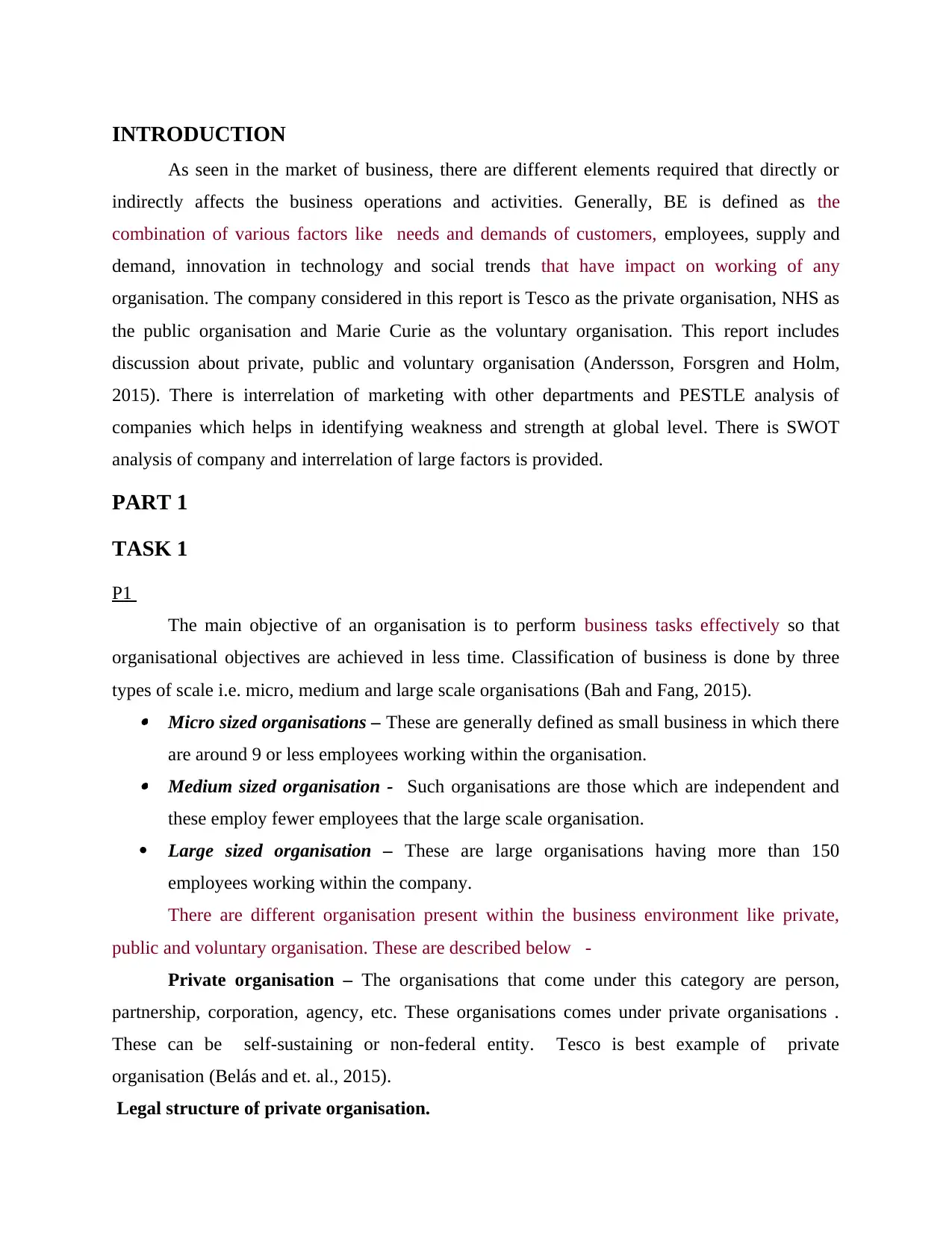
INTRODUCTION
As seen in the market of business, there are different elements required that directly or
indirectly affects the business operations and activities. Generally, BE is defined as the
combination of various factors like needs and demands of customers, employees, supply and
demand, innovation in technology and social trends that have impact on working of any
organisation. The company considered in this report is Tesco as the private organisation, NHS as
the public organisation and Marie Curie as the voluntary organisation. This report includes
discussion about private, public and voluntary organisation (Andersson, Forsgren and Holm,
2015). There is interrelation of marketing with other departments and PESTLE analysis of
companies which helps in identifying weakness and strength at global level. There is SWOT
analysis of company and interrelation of large factors is provided.
PART 1
TASK 1
P1
The main objective of an organisation is to perform business tasks effectively so that
organisational objectives are achieved in less time. Classification of business is done by three
types of scale i.e. micro, medium and large scale organisations (Bah and Fang, 2015). Micro sized organisations – These are generally defined as small business in which there
are around 9 or less employees working within the organisation. Medium sized organisation - Such organisations are those which are independent and
these employ fewer employees that the large scale organisation.
Large sized organisation – These are large organisations having more than 150
employees working within the company.
There are different organisation present within the business environment like private,
public and voluntary organisation. These are described below -
Private organisation – The organisations that come under this category are person,
partnership, corporation, agency, etc. These organisations comes under private organisations .
These can be self-sustaining or non-federal entity. Tesco is best example of private
organisation (Belás and et. al., 2015).
Legal structure of private organisation.
As seen in the market of business, there are different elements required that directly or
indirectly affects the business operations and activities. Generally, BE is defined as the
combination of various factors like needs and demands of customers, employees, supply and
demand, innovation in technology and social trends that have impact on working of any
organisation. The company considered in this report is Tesco as the private organisation, NHS as
the public organisation and Marie Curie as the voluntary organisation. This report includes
discussion about private, public and voluntary organisation (Andersson, Forsgren and Holm,
2015). There is interrelation of marketing with other departments and PESTLE analysis of
companies which helps in identifying weakness and strength at global level. There is SWOT
analysis of company and interrelation of large factors is provided.
PART 1
TASK 1
P1
The main objective of an organisation is to perform business tasks effectively so that
organisational objectives are achieved in less time. Classification of business is done by three
types of scale i.e. micro, medium and large scale organisations (Bah and Fang, 2015). Micro sized organisations – These are generally defined as small business in which there
are around 9 or less employees working within the organisation. Medium sized organisation - Such organisations are those which are independent and
these employ fewer employees that the large scale organisation.
Large sized organisation – These are large organisations having more than 150
employees working within the company.
There are different organisation present within the business environment like private,
public and voluntary organisation. These are described below -
Private organisation – The organisations that come under this category are person,
partnership, corporation, agency, etc. These organisations comes under private organisations .
These can be self-sustaining or non-federal entity. Tesco is best example of private
organisation (Belás and et. al., 2015).
Legal structure of private organisation.
⊘ This is a preview!⊘
Do you want full access?
Subscribe today to unlock all pages.

Trusted by 1+ million students worldwide
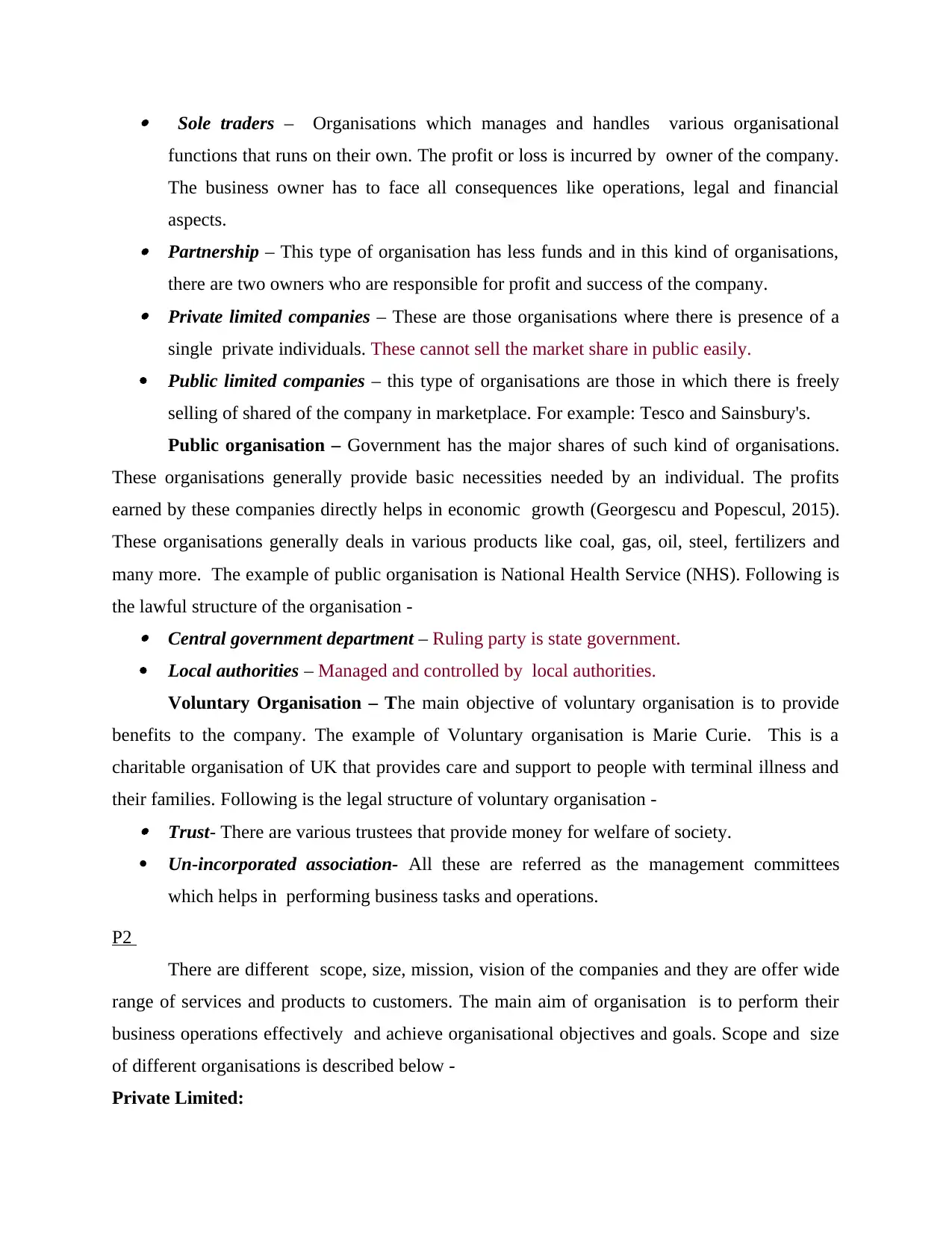
Sole traders – Organisations which manages and handles various organisational
functions that runs on their own. The profit or loss is incurred by owner of the company.
The business owner has to face all consequences like operations, legal and financial
aspects. Partnership – This type of organisation has less funds and in this kind of organisations,
there are two owners who are responsible for profit and success of the company. Private limited companies – These are those organisations where there is presence of a
single private individuals. These cannot sell the market share in public easily.
Public limited companies – this type of organisations are those in which there is freely
selling of shared of the company in marketplace. For example: Tesco and Sainsbury's.
Public organisation – Government has the major shares of such kind of organisations.
These organisations generally provide basic necessities needed by an individual. The profits
earned by these companies directly helps in economic growth (Georgescu and Popescul, 2015).
These organisations generally deals in various products like coal, gas, oil, steel, fertilizers and
many more. The example of public organisation is National Health Service (NHS). Following is
the lawful structure of the organisation - Central government department – Ruling party is state government.
Local authorities – Managed and controlled by local authorities.
Voluntary Organisation – The main objective of voluntary organisation is to provide
benefits to the company. The example of Voluntary organisation is Marie Curie. This is a
charitable organisation of UK that provides care and support to people with terminal illness and
their families. Following is the legal structure of voluntary organisation - Trust- There are various trustees that provide money for welfare of society.
Un-incorporated association- All these are referred as the management committees
which helps in performing business tasks and operations.
P2
There are different scope, size, mission, vision of the companies and they are offer wide
range of services and products to customers. The main aim of organisation is to perform their
business operations effectively and achieve organisational objectives and goals. Scope and size
of different organisations is described below -
Private Limited:
functions that runs on their own. The profit or loss is incurred by owner of the company.
The business owner has to face all consequences like operations, legal and financial
aspects. Partnership – This type of organisation has less funds and in this kind of organisations,
there are two owners who are responsible for profit and success of the company. Private limited companies – These are those organisations where there is presence of a
single private individuals. These cannot sell the market share in public easily.
Public limited companies – this type of organisations are those in which there is freely
selling of shared of the company in marketplace. For example: Tesco and Sainsbury's.
Public organisation – Government has the major shares of such kind of organisations.
These organisations generally provide basic necessities needed by an individual. The profits
earned by these companies directly helps in economic growth (Georgescu and Popescul, 2015).
These organisations generally deals in various products like coal, gas, oil, steel, fertilizers and
many more. The example of public organisation is National Health Service (NHS). Following is
the lawful structure of the organisation - Central government department – Ruling party is state government.
Local authorities – Managed and controlled by local authorities.
Voluntary Organisation – The main objective of voluntary organisation is to provide
benefits to the company. The example of Voluntary organisation is Marie Curie. This is a
charitable organisation of UK that provides care and support to people with terminal illness and
their families. Following is the legal structure of voluntary organisation - Trust- There are various trustees that provide money for welfare of society.
Un-incorporated association- All these are referred as the management committees
which helps in performing business tasks and operations.
P2
There are different scope, size, mission, vision of the companies and they are offer wide
range of services and products to customers. The main aim of organisation is to perform their
business operations effectively and achieve organisational objectives and goals. Scope and size
of different organisations is described below -
Private Limited:
Paraphrase This Document
Need a fresh take? Get an instant paraphrase of this document with our AI Paraphraser
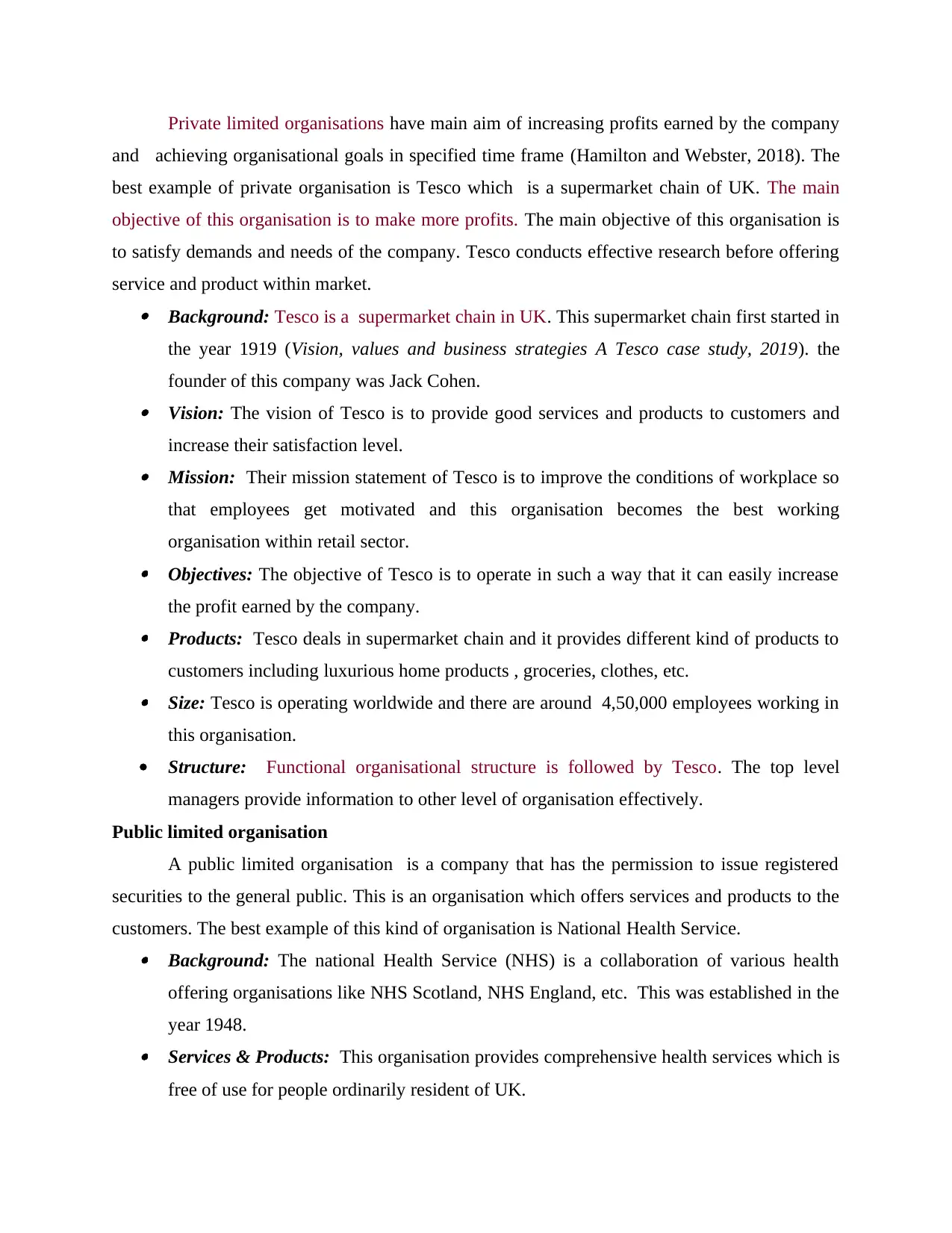
Private limited organisations have main aim of increasing profits earned by the company
and achieving organisational goals in specified time frame (Hamilton and Webster, 2018). The
best example of private organisation is Tesco which is a supermarket chain of UK. The main
objective of this organisation is to make more profits. The main objective of this organisation is
to satisfy demands and needs of the company. Tesco conducts effective research before offering
service and product within market. Background: Tesco is a supermarket chain in UK. This supermarket chain first started in
the year 1919 (Vision, values and business strategies A Tesco case study, 2019). the
founder of this company was Jack Cohen. Vision: The vision of Tesco is to provide good services and products to customers and
increase their satisfaction level. Mission: Their mission statement of Tesco is to improve the conditions of workplace so
that employees get motivated and this organisation becomes the best working
organisation within retail sector. Objectives: The objective of Tesco is to operate in such a way that it can easily increase
the profit earned by the company. Products: Tesco deals in supermarket chain and it provides different kind of products to
customers including luxurious home products , groceries, clothes, etc. Size: Tesco is operating worldwide and there are around 4,50,000 employees working in
this organisation.
Structure: Functional organisational structure is followed by Tesco. The top level
managers provide information to other level of organisation effectively.
Public limited organisation
A public limited organisation is a company that has the permission to issue registered
securities to the general public. This is an organisation which offers services and products to the
customers. The best example of this kind of organisation is National Health Service. Background: The national Health Service (NHS) is a collaboration of various health
offering organisations like NHS Scotland, NHS England, etc. This was established in the
year 1948. Services & Products: This organisation provides comprehensive health services which is
free of use for people ordinarily resident of UK.
and achieving organisational goals in specified time frame (Hamilton and Webster, 2018). The
best example of private organisation is Tesco which is a supermarket chain of UK. The main
objective of this organisation is to make more profits. The main objective of this organisation is
to satisfy demands and needs of the company. Tesco conducts effective research before offering
service and product within market. Background: Tesco is a supermarket chain in UK. This supermarket chain first started in
the year 1919 (Vision, values and business strategies A Tesco case study, 2019). the
founder of this company was Jack Cohen. Vision: The vision of Tesco is to provide good services and products to customers and
increase their satisfaction level. Mission: Their mission statement of Tesco is to improve the conditions of workplace so
that employees get motivated and this organisation becomes the best working
organisation within retail sector. Objectives: The objective of Tesco is to operate in such a way that it can easily increase
the profit earned by the company. Products: Tesco deals in supermarket chain and it provides different kind of products to
customers including luxurious home products , groceries, clothes, etc. Size: Tesco is operating worldwide and there are around 4,50,000 employees working in
this organisation.
Structure: Functional organisational structure is followed by Tesco. The top level
managers provide information to other level of organisation effectively.
Public limited organisation
A public limited organisation is a company that has the permission to issue registered
securities to the general public. This is an organisation which offers services and products to the
customers. The best example of this kind of organisation is National Health Service. Background: The national Health Service (NHS) is a collaboration of various health
offering organisations like NHS Scotland, NHS England, etc. This was established in the
year 1948. Services & Products: This organisation provides comprehensive health services which is
free of use for people ordinarily resident of UK.
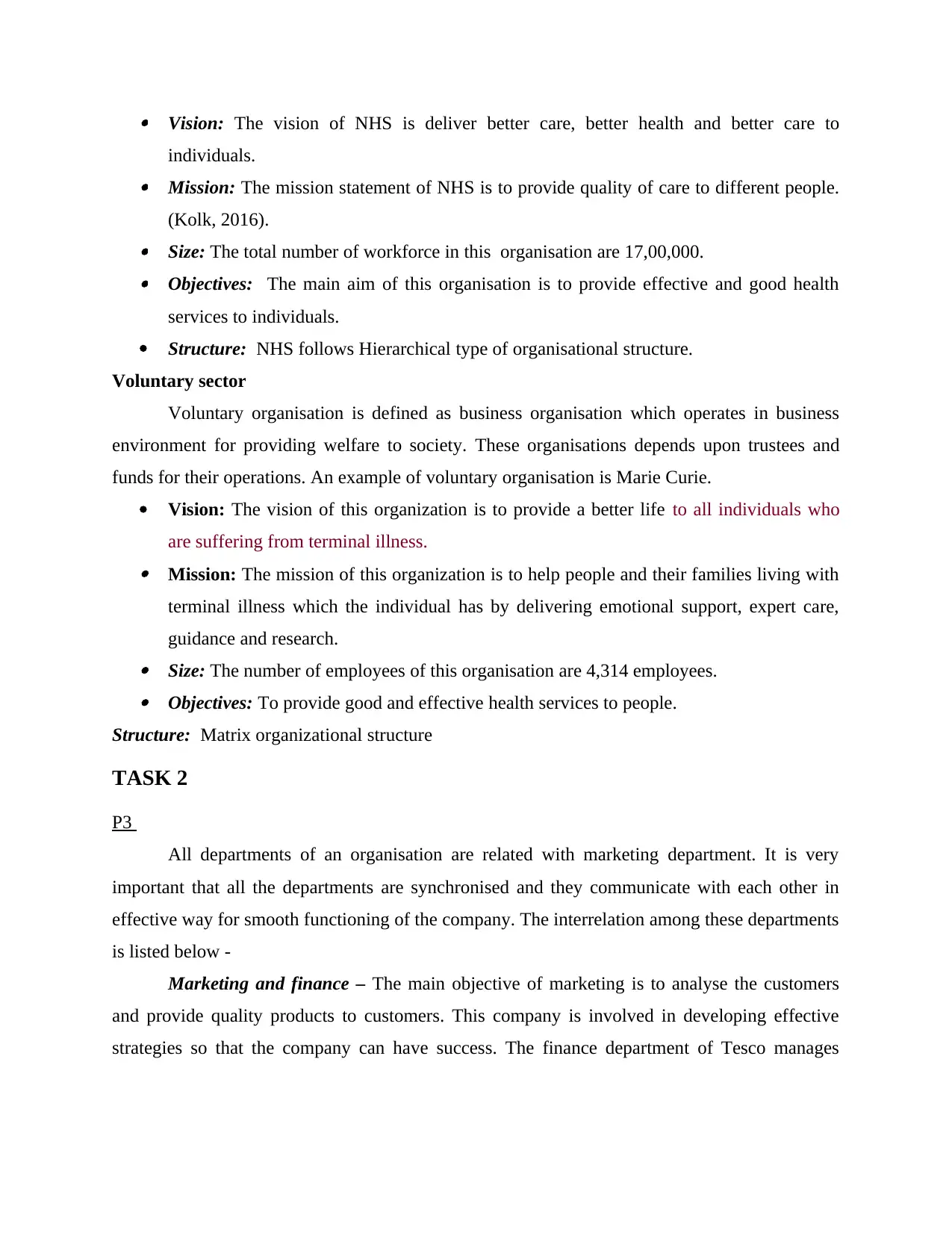
Vision: The vision of NHS is deliver better care, better health and better care to
individuals. Mission: The mission statement of NHS is to provide quality of care to different people.
(Kolk, 2016). Size: The total number of workforce in this organisation are 17,00,000. Objectives: The main aim of this organisation is to provide effective and good health
services to individuals.
Structure: NHS follows Hierarchical type of organisational structure.
Voluntary sector
Voluntary organisation is defined as business organisation which operates in business
environment for providing welfare to society. These organisations depends upon trustees and
funds for their operations. An example of voluntary organisation is Marie Curie.
Vision: The vision of this organization is to provide a better life to all individuals who
are suffering from terminal illness. Mission: The mission of this organization is to help people and their families living with
terminal illness which the individual has by delivering emotional support, expert care,
guidance and research. Size: The number of employees of this organisation are 4,314 employees. Objectives: To provide good and effective health services to people.
Structure: Matrix organizational structure
TASK 2
P3
All departments of an organisation are related with marketing department. It is very
important that all the departments are synchronised and they communicate with each other in
effective way for smooth functioning of the company. The interrelation among these departments
is listed below -
Marketing and finance – The main objective of marketing is to analyse the customers
and provide quality products to customers. This company is involved in developing effective
strategies so that the company can have success. The finance department of Tesco manages
individuals. Mission: The mission statement of NHS is to provide quality of care to different people.
(Kolk, 2016). Size: The total number of workforce in this organisation are 17,00,000. Objectives: The main aim of this organisation is to provide effective and good health
services to individuals.
Structure: NHS follows Hierarchical type of organisational structure.
Voluntary sector
Voluntary organisation is defined as business organisation which operates in business
environment for providing welfare to society. These organisations depends upon trustees and
funds for their operations. An example of voluntary organisation is Marie Curie.
Vision: The vision of this organization is to provide a better life to all individuals who
are suffering from terminal illness. Mission: The mission of this organization is to help people and their families living with
terminal illness which the individual has by delivering emotional support, expert care,
guidance and research. Size: The number of employees of this organisation are 4,314 employees. Objectives: To provide good and effective health services to people.
Structure: Matrix organizational structure
TASK 2
P3
All departments of an organisation are related with marketing department. It is very
important that all the departments are synchronised and they communicate with each other in
effective way for smooth functioning of the company. The interrelation among these departments
is listed below -
Marketing and finance – The main objective of marketing is to analyse the customers
and provide quality products to customers. This company is involved in developing effective
strategies so that the company can have success. The finance department of Tesco manages
⊘ This is a preview!⊘
Do you want full access?
Subscribe today to unlock all pages.

Trusted by 1+ million students worldwide
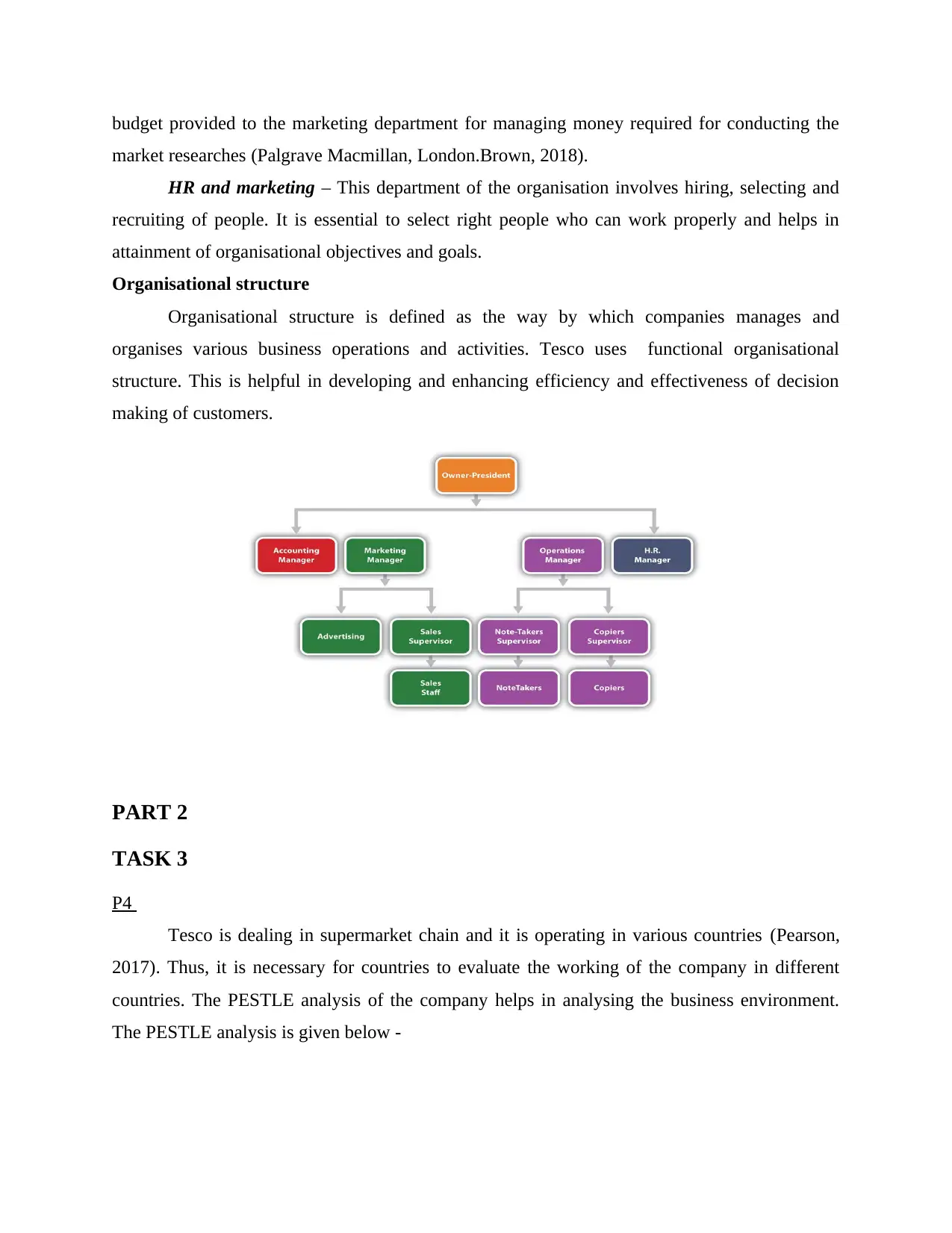
budget provided to the marketing department for managing money required for conducting the
market researches (Palgrave Macmillan, London.Brown, 2018).
HR and marketing – This department of the organisation involves hiring, selecting and
recruiting of people. It is essential to select right people who can work properly and helps in
attainment of organisational objectives and goals.
Organisational structure
Organisational structure is defined as the way by which companies manages and
organises various business operations and activities. Tesco uses functional organisational
structure. This is helpful in developing and enhancing efficiency and effectiveness of decision
making of customers.
PART 2
TASK 3
P4
Tesco is dealing in supermarket chain and it is operating in various countries (Pearson,
2017). Thus, it is necessary for countries to evaluate the working of the company in different
countries. The PESTLE analysis of the company helps in analysing the business environment.
The PESTLE analysis is given below -
market researches (Palgrave Macmillan, London.Brown, 2018).
HR and marketing – This department of the organisation involves hiring, selecting and
recruiting of people. It is essential to select right people who can work properly and helps in
attainment of organisational objectives and goals.
Organisational structure
Organisational structure is defined as the way by which companies manages and
organises various business operations and activities. Tesco uses functional organisational
structure. This is helpful in developing and enhancing efficiency and effectiveness of decision
making of customers.
PART 2
TASK 3
P4
Tesco is dealing in supermarket chain and it is operating in various countries (Pearson,
2017). Thus, it is necessary for countries to evaluate the working of the company in different
countries. The PESTLE analysis of the company helps in analysing the business environment.
The PESTLE analysis is given below -
Paraphrase This Document
Need a fresh take? Get an instant paraphrase of this document with our AI Paraphraser
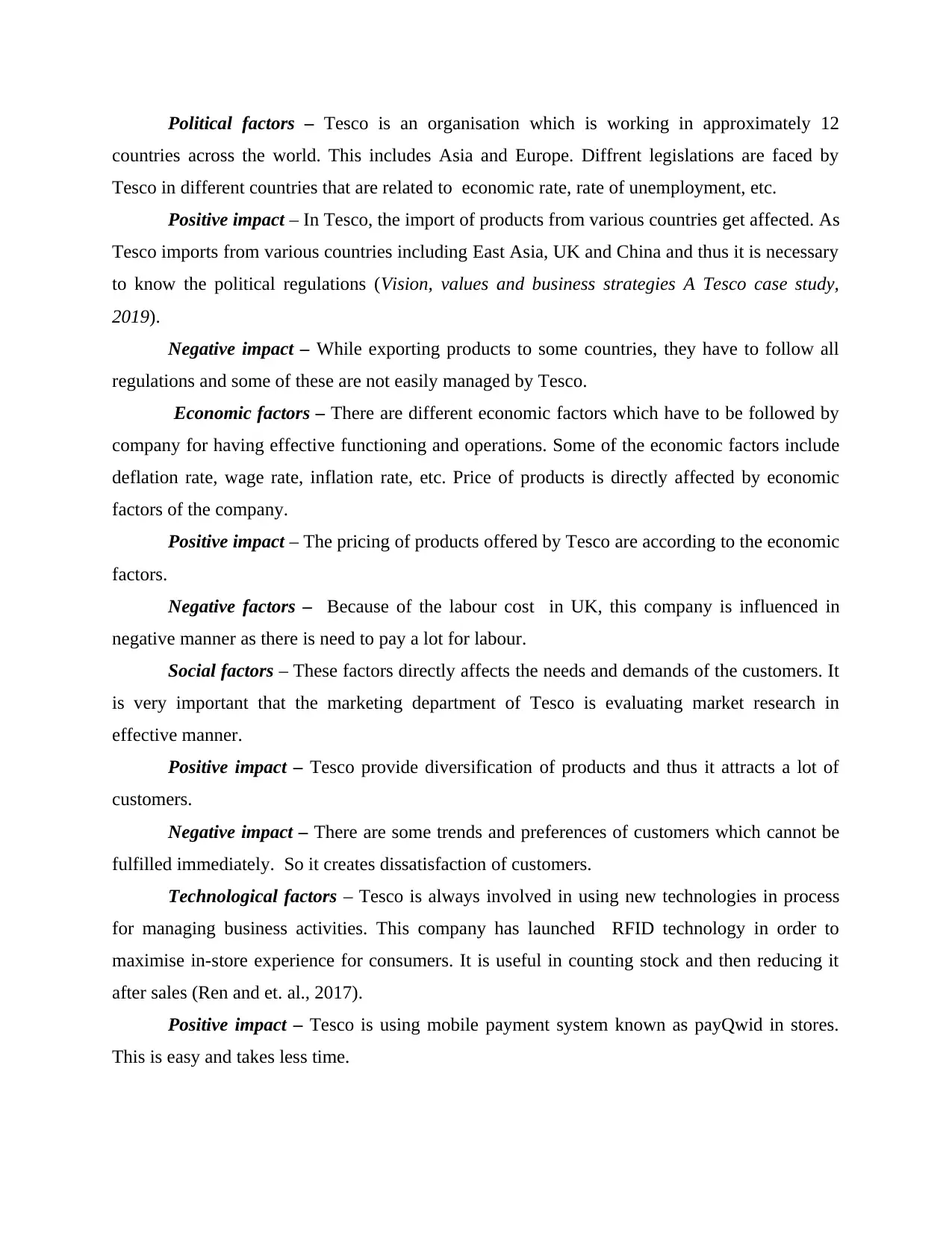
Political factors – Tesco is an organisation which is working in approximately 12
countries across the world. This includes Asia and Europe. Diffrent legislations are faced by
Tesco in different countries that are related to economic rate, rate of unemployment, etc.
Positive impact – In Tesco, the import of products from various countries get affected. As
Tesco imports from various countries including East Asia, UK and China and thus it is necessary
to know the political regulations (Vision, values and business strategies A Tesco case study,
2019).
Negative impact – While exporting products to some countries, they have to follow all
regulations and some of these are not easily managed by Tesco.
Economic factors – There are different economic factors which have to be followed by
company for having effective functioning and operations. Some of the economic factors include
deflation rate, wage rate, inflation rate, etc. Price of products is directly affected by economic
factors of the company.
Positive impact – The pricing of products offered by Tesco are according to the economic
factors.
Negative factors – Because of the labour cost in UK, this company is influenced in
negative manner as there is need to pay a lot for labour.
Social factors – These factors directly affects the needs and demands of the customers. It
is very important that the marketing department of Tesco is evaluating market research in
effective manner.
Positive impact – Tesco provide diversification of products and thus it attracts a lot of
customers.
Negative impact – There are some trends and preferences of customers which cannot be
fulfilled immediately. So it creates dissatisfaction of customers.
Technological factors – Tesco is always involved in using new technologies in process
for managing business activities. This company has launched RFID technology in order to
maximise in-store experience for consumers. It is useful in counting stock and then reducing it
after sales (Ren and et. al., 2017).
Positive impact – Tesco is using mobile payment system known as payQwid in stores.
This is easy and takes less time.
countries across the world. This includes Asia and Europe. Diffrent legislations are faced by
Tesco in different countries that are related to economic rate, rate of unemployment, etc.
Positive impact – In Tesco, the import of products from various countries get affected. As
Tesco imports from various countries including East Asia, UK and China and thus it is necessary
to know the political regulations (Vision, values and business strategies A Tesco case study,
2019).
Negative impact – While exporting products to some countries, they have to follow all
regulations and some of these are not easily managed by Tesco.
Economic factors – There are different economic factors which have to be followed by
company for having effective functioning and operations. Some of the economic factors include
deflation rate, wage rate, inflation rate, etc. Price of products is directly affected by economic
factors of the company.
Positive impact – The pricing of products offered by Tesco are according to the economic
factors.
Negative factors – Because of the labour cost in UK, this company is influenced in
negative manner as there is need to pay a lot for labour.
Social factors – These factors directly affects the needs and demands of the customers. It
is very important that the marketing department of Tesco is evaluating market research in
effective manner.
Positive impact – Tesco provide diversification of products and thus it attracts a lot of
customers.
Negative impact – There are some trends and preferences of customers which cannot be
fulfilled immediately. So it creates dissatisfaction of customers.
Technological factors – Tesco is always involved in using new technologies in process
for managing business activities. This company has launched RFID technology in order to
maximise in-store experience for consumers. It is useful in counting stock and then reducing it
after sales (Ren and et. al., 2017).
Positive impact – Tesco is using mobile payment system known as payQwid in stores.
This is easy and takes less time.
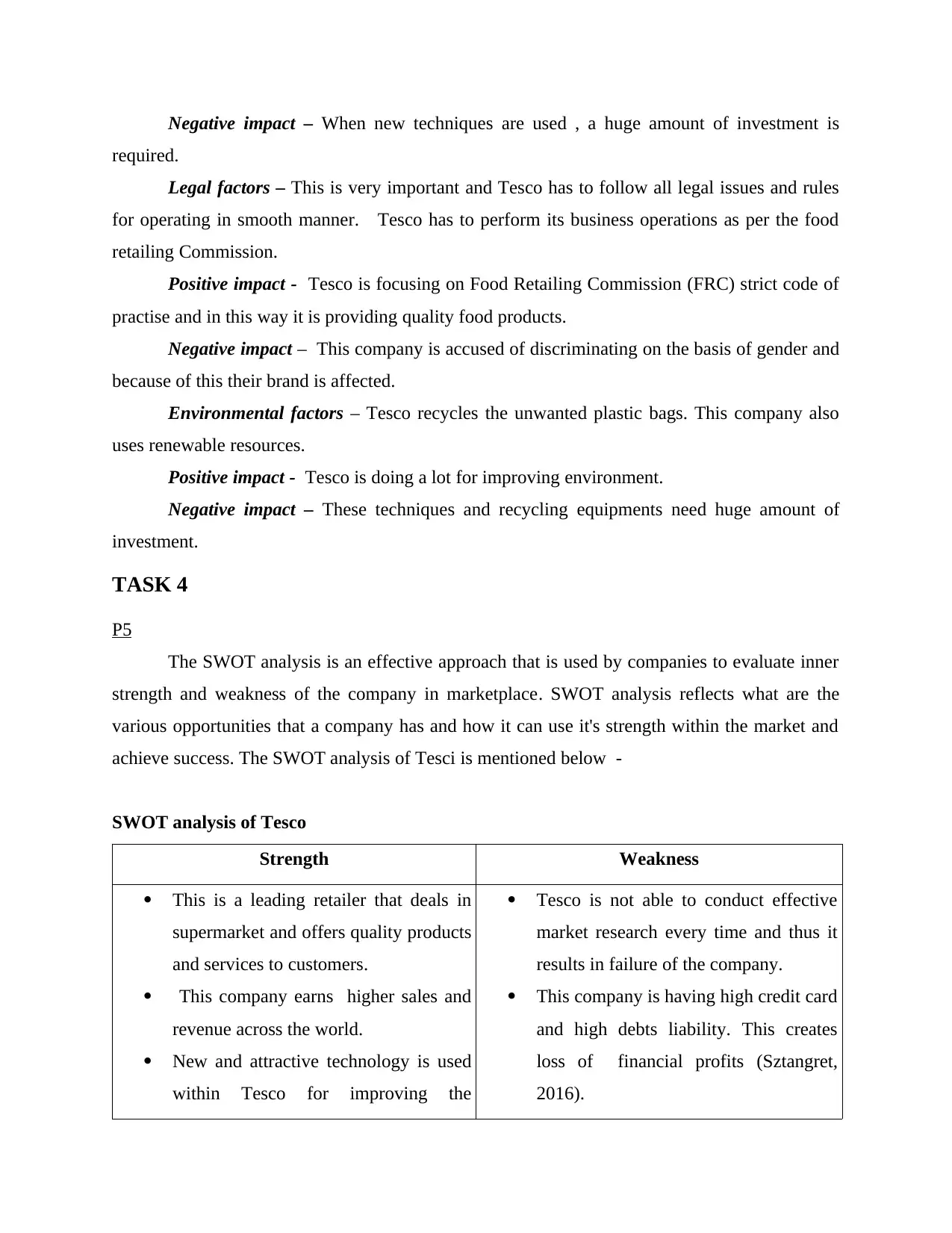
Negative impact – When new techniques are used , a huge amount of investment is
required.
Legal factors – This is very important and Tesco has to follow all legal issues and rules
for operating in smooth manner. Tesco has to perform its business operations as per the food
retailing Commission.
Positive impact - Tesco is focusing on Food Retailing Commission (FRC) strict code of
practise and in this way it is providing quality food products.
Negative impact – This company is accused of discriminating on the basis of gender and
because of this their brand is affected.
Environmental factors – Tesco recycles the unwanted plastic bags. This company also
uses renewable resources.
Positive impact - Tesco is doing a lot for improving environment.
Negative impact – These techniques and recycling equipments need huge amount of
investment.
TASK 4
P5
The SWOT analysis is an effective approach that is used by companies to evaluate inner
strength and weakness of the company in marketplace. SWOT analysis reflects what are the
various opportunities that a company has and how it can use it's strength within the market and
achieve success. The SWOT analysis of Tesci is mentioned below -
SWOT analysis of Tesco
Strength Weakness
This is a leading retailer that deals in
supermarket and offers quality products
and services to customers.
This company earns higher sales and
revenue across the world.
New and attractive technology is used
within Tesco for improving the
Tesco is not able to conduct effective
market research every time and thus it
results in failure of the company.
This company is having high credit card
and high debts liability. This creates
loss of financial profits (Sztangret,
2016).
required.
Legal factors – This is very important and Tesco has to follow all legal issues and rules
for operating in smooth manner. Tesco has to perform its business operations as per the food
retailing Commission.
Positive impact - Tesco is focusing on Food Retailing Commission (FRC) strict code of
practise and in this way it is providing quality food products.
Negative impact – This company is accused of discriminating on the basis of gender and
because of this their brand is affected.
Environmental factors – Tesco recycles the unwanted plastic bags. This company also
uses renewable resources.
Positive impact - Tesco is doing a lot for improving environment.
Negative impact – These techniques and recycling equipments need huge amount of
investment.
TASK 4
P5
The SWOT analysis is an effective approach that is used by companies to evaluate inner
strength and weakness of the company in marketplace. SWOT analysis reflects what are the
various opportunities that a company has and how it can use it's strength within the market and
achieve success. The SWOT analysis of Tesci is mentioned below -
SWOT analysis of Tesco
Strength Weakness
This is a leading retailer that deals in
supermarket and offers quality products
and services to customers.
This company earns higher sales and
revenue across the world.
New and attractive technology is used
within Tesco for improving the
Tesco is not able to conduct effective
market research every time and thus it
results in failure of the company.
This company is having high credit card
and high debts liability. This creates
loss of financial profits (Sztangret,
2016).
⊘ This is a preview!⊘
Do you want full access?
Subscribe today to unlock all pages.

Trusted by 1+ million students worldwide
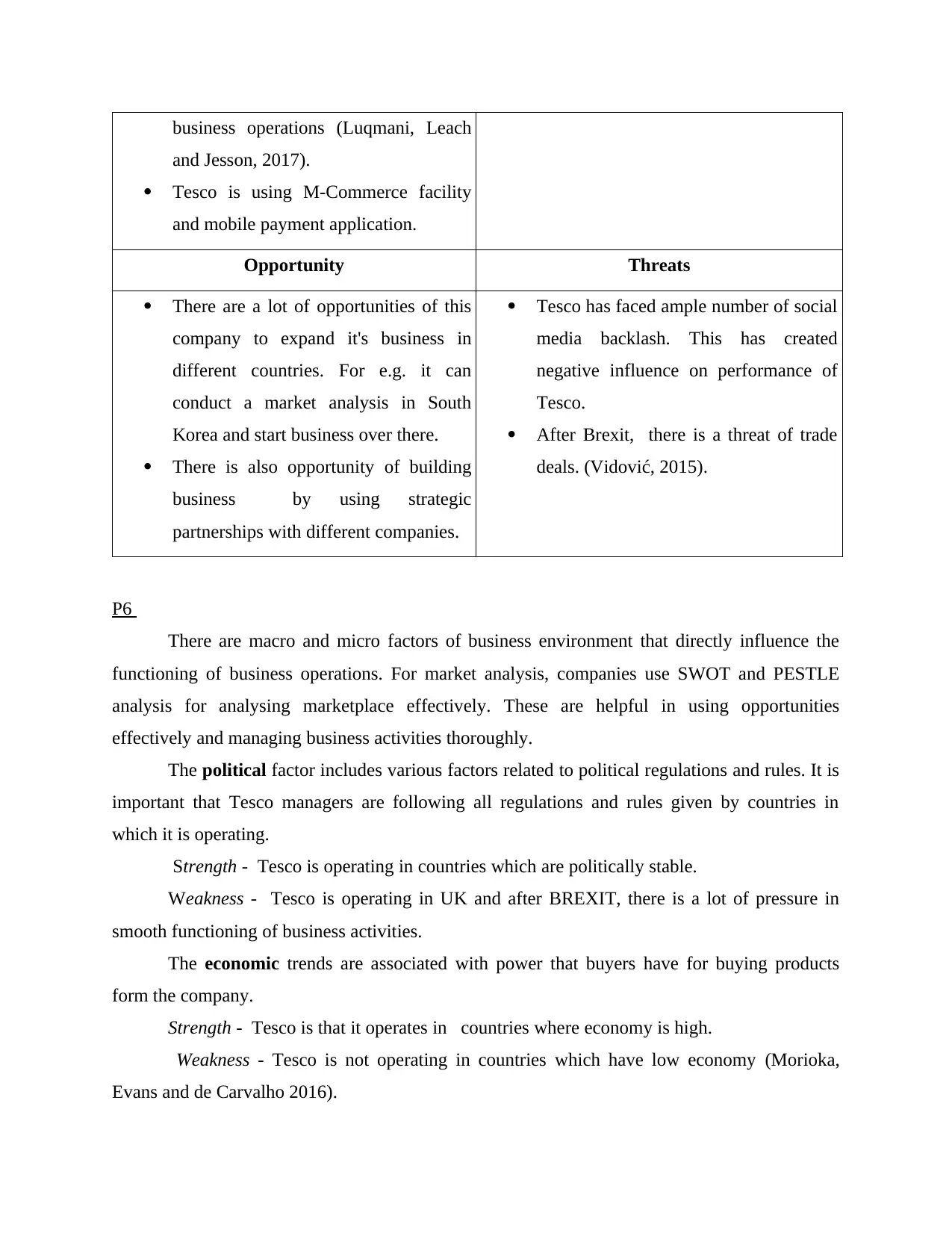
business operations (Luqmani, Leach
and Jesson, 2017).
Tesco is using M-Commerce facility
and mobile payment application.
Opportunity Threats
There are a lot of opportunities of this
company to expand it's business in
different countries. For e.g. it can
conduct a market analysis in South
Korea and start business over there.
There is also opportunity of building
business by using strategic
partnerships with different companies.
Tesco has faced ample number of social
media backlash. This has created
negative influence on performance of
Tesco.
After Brexit, there is a threat of trade
deals. (Vidović, 2015).
P6
There are macro and micro factors of business environment that directly influence the
functioning of business operations. For market analysis, companies use SWOT and PESTLE
analysis for analysing marketplace effectively. These are helpful in using opportunities
effectively and managing business activities thoroughly.
The political factor includes various factors related to political regulations and rules. It is
important that Tesco managers are following all regulations and rules given by countries in
which it is operating.
Strength - Tesco is operating in countries which are politically stable.
Weakness - Tesco is operating in UK and after BREXIT, there is a lot of pressure in
smooth functioning of business activities.
The economic trends are associated with power that buyers have for buying products
form the company.
Strength - Tesco is that it operates in countries where economy is high.
Weakness - Tesco is not operating in countries which have low economy (Morioka,
Evans and de Carvalho 2016).
and Jesson, 2017).
Tesco is using M-Commerce facility
and mobile payment application.
Opportunity Threats
There are a lot of opportunities of this
company to expand it's business in
different countries. For e.g. it can
conduct a market analysis in South
Korea and start business over there.
There is also opportunity of building
business by using strategic
partnerships with different companies.
Tesco has faced ample number of social
media backlash. This has created
negative influence on performance of
Tesco.
After Brexit, there is a threat of trade
deals. (Vidović, 2015).
P6
There are macro and micro factors of business environment that directly influence the
functioning of business operations. For market analysis, companies use SWOT and PESTLE
analysis for analysing marketplace effectively. These are helpful in using opportunities
effectively and managing business activities thoroughly.
The political factor includes various factors related to political regulations and rules. It is
important that Tesco managers are following all regulations and rules given by countries in
which it is operating.
Strength - Tesco is operating in countries which are politically stable.
Weakness - Tesco is operating in UK and after BREXIT, there is a lot of pressure in
smooth functioning of business activities.
The economic trends are associated with power that buyers have for buying products
form the company.
Strength - Tesco is that it operates in countries where economy is high.
Weakness - Tesco is not operating in countries which have low economy (Morioka,
Evans and de Carvalho 2016).
Paraphrase This Document
Need a fresh take? Get an instant paraphrase of this document with our AI Paraphraser
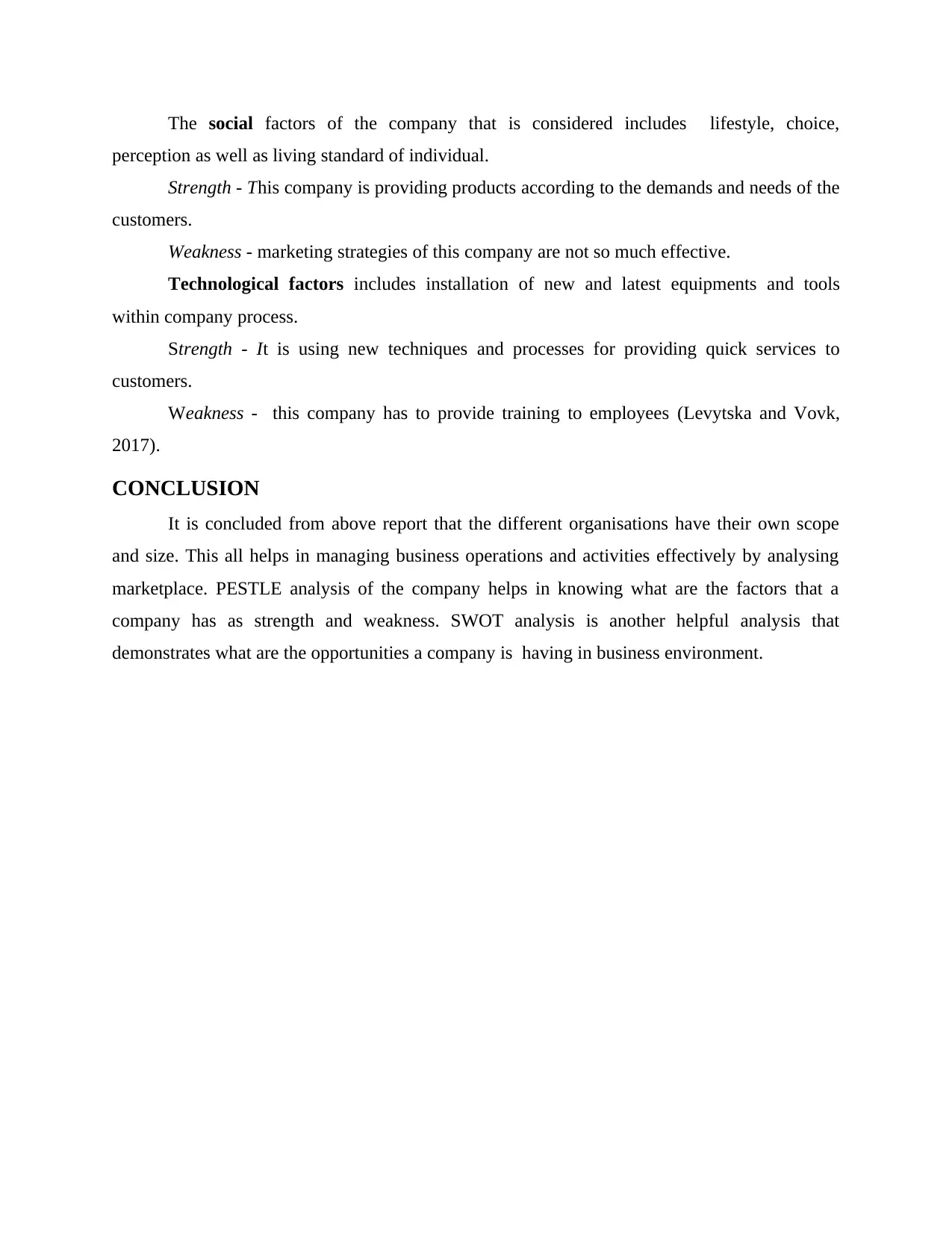
The social factors of the company that is considered includes lifestyle, choice,
perception as well as living standard of individual.
Strength - This company is providing products according to the demands and needs of the
customers.
Weakness - marketing strategies of this company are not so much effective.
Technological factors includes installation of new and latest equipments and tools
within company process.
Strength - It is using new techniques and processes for providing quick services to
customers.
Weakness - this company has to provide training to employees (Levytska and Vovk,
2017).
CONCLUSION
It is concluded from above report that the different organisations have their own scope
and size. This all helps in managing business operations and activities effectively by analysing
marketplace. PESTLE analysis of the company helps in knowing what are the factors that a
company has as strength and weakness. SWOT analysis is another helpful analysis that
demonstrates what are the opportunities a company is having in business environment.
perception as well as living standard of individual.
Strength - This company is providing products according to the demands and needs of the
customers.
Weakness - marketing strategies of this company are not so much effective.
Technological factors includes installation of new and latest equipments and tools
within company process.
Strength - It is using new techniques and processes for providing quick services to
customers.
Weakness - this company has to provide training to employees (Levytska and Vovk,
2017).
CONCLUSION
It is concluded from above report that the different organisations have their own scope
and size. This all helps in managing business operations and activities effectively by analysing
marketplace. PESTLE analysis of the company helps in knowing what are the factors that a
company has as strength and weakness. SWOT analysis is another helpful analysis that
demonstrates what are the opportunities a company is having in business environment.
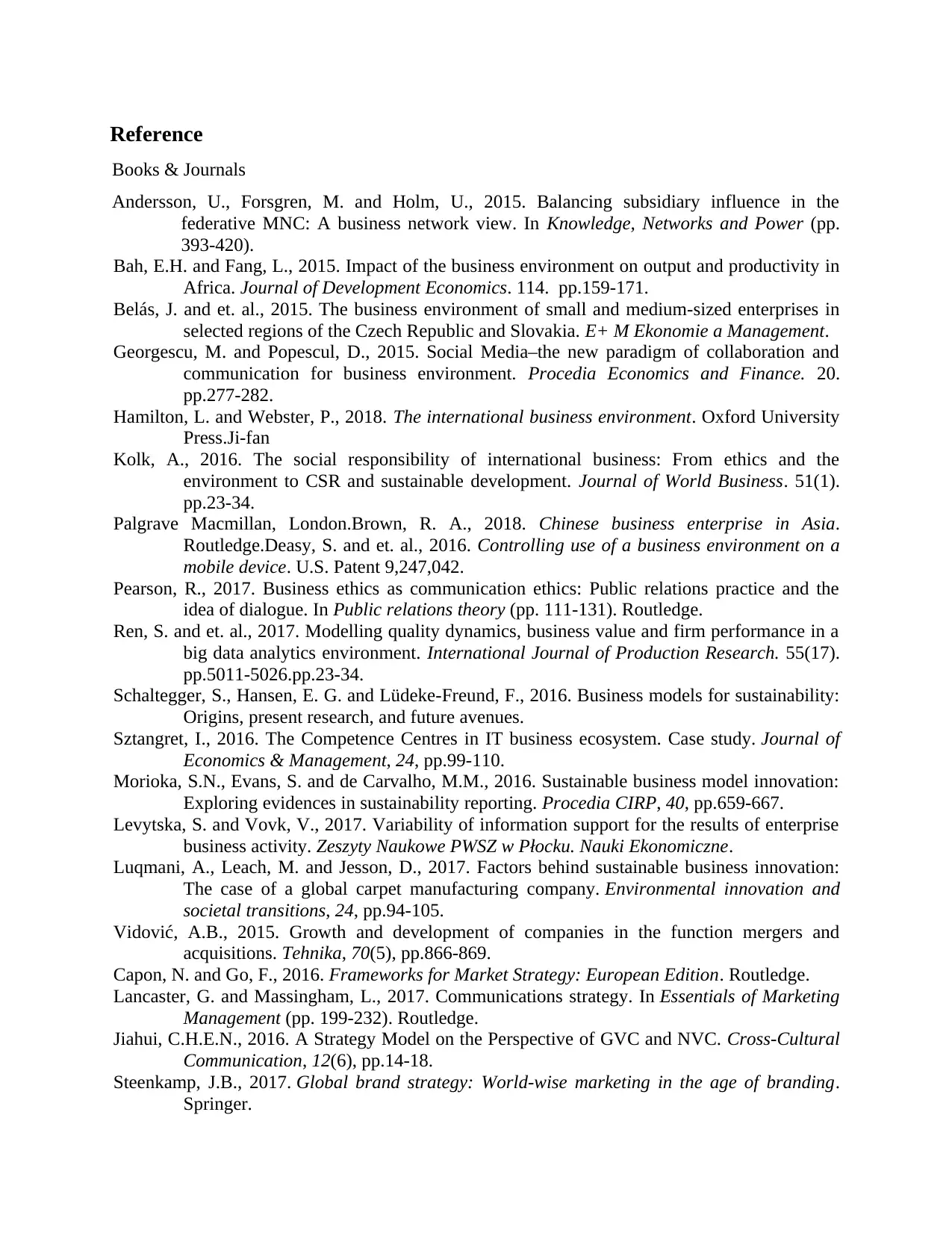
Reference
Books & Journals
Andersson, U., Forsgren, M. and Holm, U., 2015. Balancing subsidiary influence in the
federative MNC: A business network view. In Knowledge, Networks and Power (pp.
393-420).
Bah, E.H. and Fang, L., 2015. Impact of the business environment on output and productivity in
Africa. Journal of Development Economics. 114. pp.159-171.
Belás, J. and et. al., 2015. The business environment of small and medium-sized enterprises in
selected regions of the Czech Republic and Slovakia. E+ M Ekonomie a Management.
Georgescu, M. and Popescul, D., 2015. Social Media–the new paradigm of collaboration and
communication for business environment. Procedia Economics and Finance. 20.
pp.277-282.
Hamilton, L. and Webster, P., 2018. The international business environment. Oxford University
Press.Ji-fan
Kolk, A., 2016. The social responsibility of international business: From ethics and the
environment to CSR and sustainable development. Journal of World Business. 51(1).
pp.23-34.
Palgrave Macmillan, London.Brown, R. A., 2018. Chinese business enterprise in Asia.
Routledge.Deasy, S. and et. al., 2016. Controlling use of a business environment on a
mobile device. U.S. Patent 9,247,042.
Pearson, R., 2017. Business ethics as communication ethics: Public relations practice and the
idea of dialogue. In Public relations theory (pp. 111-131). Routledge.
Ren, S. and et. al., 2017. Modelling quality dynamics, business value and firm performance in a
big data analytics environment. International Journal of Production Research. 55(17).
pp.5011-5026.pp.23-34.
Schaltegger, S., Hansen, E. G. and Lüdeke-Freund, F., 2016. Business models for sustainability:
Origins, present research, and future avenues.
Sztangret, I., 2016. The Competence Centres in IT business ecosystem. Case study. Journal of
Economics & Management, 24, pp.99-110.
Morioka, S.N., Evans, S. and de Carvalho, M.M., 2016. Sustainable business model innovation:
Exploring evidences in sustainability reporting. Procedia CIRP, 40, pp.659-667.
Levytska, S. and Vovk, V., 2017. Variability of information support for the results of enterprise
business activity. Zeszyty Naukowe PWSZ w Płocku. Nauki Ekonomiczne.
Luqmani, A., Leach, M. and Jesson, D., 2017. Factors behind sustainable business innovation:
The case of a global carpet manufacturing company. Environmental innovation and
societal transitions, 24, pp.94-105.
Vidović, A.B., 2015. Growth and development of companies in the function mergers and
acquisitions. Tehnika, 70(5), pp.866-869.
Capon, N. and Go, F., 2016. Frameworks for Market Strategy: European Edition. Routledge.
Lancaster, G. and Massingham, L., 2017. Communications strategy. In Essentials of Marketing
Management (pp. 199-232). Routledge.
Jiahui, C.H.E.N., 2016. A Strategy Model on the Perspective of GVC and NVC. Cross-Cultural
Communication, 12(6), pp.14-18.
Steenkamp, J.B., 2017. Global brand strategy: World-wise marketing in the age of branding.
Springer.
Books & Journals
Andersson, U., Forsgren, M. and Holm, U., 2015. Balancing subsidiary influence in the
federative MNC: A business network view. In Knowledge, Networks and Power (pp.
393-420).
Bah, E.H. and Fang, L., 2015. Impact of the business environment on output and productivity in
Africa. Journal of Development Economics. 114. pp.159-171.
Belás, J. and et. al., 2015. The business environment of small and medium-sized enterprises in
selected regions of the Czech Republic and Slovakia. E+ M Ekonomie a Management.
Georgescu, M. and Popescul, D., 2015. Social Media–the new paradigm of collaboration and
communication for business environment. Procedia Economics and Finance. 20.
pp.277-282.
Hamilton, L. and Webster, P., 2018. The international business environment. Oxford University
Press.Ji-fan
Kolk, A., 2016. The social responsibility of international business: From ethics and the
environment to CSR and sustainable development. Journal of World Business. 51(1).
pp.23-34.
Palgrave Macmillan, London.Brown, R. A., 2018. Chinese business enterprise in Asia.
Routledge.Deasy, S. and et. al., 2016. Controlling use of a business environment on a
mobile device. U.S. Patent 9,247,042.
Pearson, R., 2017. Business ethics as communication ethics: Public relations practice and the
idea of dialogue. In Public relations theory (pp. 111-131). Routledge.
Ren, S. and et. al., 2017. Modelling quality dynamics, business value and firm performance in a
big data analytics environment. International Journal of Production Research. 55(17).
pp.5011-5026.pp.23-34.
Schaltegger, S., Hansen, E. G. and Lüdeke-Freund, F., 2016. Business models for sustainability:
Origins, present research, and future avenues.
Sztangret, I., 2016. The Competence Centres in IT business ecosystem. Case study. Journal of
Economics & Management, 24, pp.99-110.
Morioka, S.N., Evans, S. and de Carvalho, M.M., 2016. Sustainable business model innovation:
Exploring evidences in sustainability reporting. Procedia CIRP, 40, pp.659-667.
Levytska, S. and Vovk, V., 2017. Variability of information support for the results of enterprise
business activity. Zeszyty Naukowe PWSZ w Płocku. Nauki Ekonomiczne.
Luqmani, A., Leach, M. and Jesson, D., 2017. Factors behind sustainable business innovation:
The case of a global carpet manufacturing company. Environmental innovation and
societal transitions, 24, pp.94-105.
Vidović, A.B., 2015. Growth and development of companies in the function mergers and
acquisitions. Tehnika, 70(5), pp.866-869.
Capon, N. and Go, F., 2016. Frameworks for Market Strategy: European Edition. Routledge.
Lancaster, G. and Massingham, L., 2017. Communications strategy. In Essentials of Marketing
Management (pp. 199-232). Routledge.
Jiahui, C.H.E.N., 2016. A Strategy Model on the Perspective of GVC and NVC. Cross-Cultural
Communication, 12(6), pp.14-18.
Steenkamp, J.B., 2017. Global brand strategy: World-wise marketing in the age of branding.
Springer.
⊘ This is a preview!⊘
Do you want full access?
Subscribe today to unlock all pages.

Trusted by 1+ million students worldwide
1 out of 13
Related Documents
Your All-in-One AI-Powered Toolkit for Academic Success.
+13062052269
info@desklib.com
Available 24*7 on WhatsApp / Email
![[object Object]](/_next/static/media/star-bottom.7253800d.svg)
Unlock your academic potential
Copyright © 2020–2025 A2Z Services. All Rights Reserved. Developed and managed by ZUCOL.





